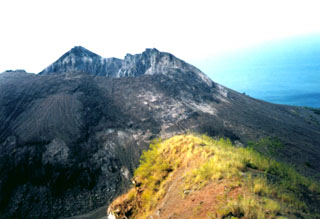Report on Iliwerung (Indonesia) — 24 November-30 November 2021
Smithsonian Institution / US Geological Survey
Weekly Volcanic Activity Report, 24 November-30 November 2021
Managing Editor: Sally Sennert.
Please cite this report as:
Global Volcanism Program, 2021. Report on Iliwerung (Indonesia) (Sennert, S, ed.). Weekly Volcanic Activity Report, 24 November-30 November 2021. Smithsonian Institution and US Geological Survey.
Iliwerung
Indonesia
8.532°S, 123.573°E; summit elev. 583 m
All times are local (unless otherwise noted)
A submarine eruption at Iliwerung was observed during 28-29 November, prompting PVMBG to raise the Alert Level to 2 (on a scale of 0-4). Residents reported seeing the sea surface, 30 m from the shore to the S, bubbling up to heights of less than 1 m beginning at 2152 on 28 November; the activity lasted about an hour. Eruptive activity at the sea surface was again observed at 0517 on 29 November. An observer described bubbling water and a plume rising about 100 m a few hours later, at 0829, though they noted that the activity was about 1 km S of the Hobal submarine vent (about 3 km E of the summit), the site of multiple eruptions since 1973. PVMBG warned residents to stay away from the coastline and the water nearest to the activity.
Geological Summary. Constructed on the southern rim of the Lerek caldera, Iliwerung forms a prominent south-facing peninsula on Lembata (formerly Lomblen) Island. Craters and lava domes have formed along N-S and NW-SE lines on the complex volcano; activity has been observed at vents from the summit to the submarine SE flank. The summit lava dome was formed during an eruption in 1870. In 1948 the Iligripe lava dome grew on the E flank at 120 m elevation. Beginning in 1973-74, when three ephemeral islands were formed, submarine eruptions began on the lower ESE flank at a vent named Hobal; several other eruptions have since taken place at this vent.
Source: Pusat Vulkanologi dan Mitigasi Bencana Geologi (PVMBG, also known as CVGHM)

